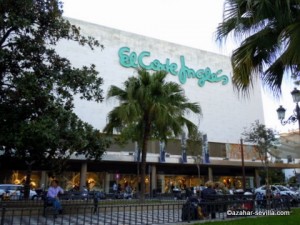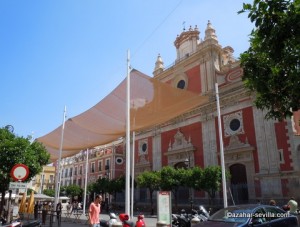 It’s not exactly a “barrio”, but the main commercial area running west to east along the main streets from the Puerta Real to the Puerta Osario, together with the main shopping streets, Calle Tetuan and Calle Sierpes running south to Plaza Nueva and Plaza San Francisco. Although this area lost more to ill-conceived modernisation projects in the fifties and sixties than any other part of the old city, there is still plenty to see and do, so it’s not all about the shopping.
It’s not exactly a “barrio”, but the main commercial area running west to east along the main streets from the Puerta Real to the Puerta Osario, together with the main shopping streets, Calle Tetuan and Calle Sierpes running south to Plaza Nueva and Plaza San Francisco. Although this area lost more to ill-conceived modernisation projects in the fifties and sixties than any other part of the old city, there is still plenty to see and do, so it’s not all about the shopping.
From the geographical centre of the city, the Plaza del Duque and La Campana, follow Sierpes or Tetuan until you come to the Ayuntamiento, or city hall, with its intricately, but only partially, decorated exterior. It was built in the sixteenth century alongside the Plaza San Francisco, so named for the Franciscan Convento Casa Grande, which occupied the area that is now the Plaza Nueva and beyond. This huge building was only finally demolished in 1840, and replaced by the large public square we see today, the city hall being extensively renovated with a new classical facade facing the square. It’s interesting to try and visualise what the area must have looked like before it had its present layout.
 Leaving the Plaza San Francisco by the street Entre Carceles (Between Prisons – once literally true, though both have long since disappeared) you arrive almost immediately at the Church of San Salvador, in the plaza of the same name. After the cathedral, this stunning baroque building constructed in the late 17th century on the site of a former Mosque, and only recently restored, is the largest church in Seville. Part of its charm, for me, is that it is almost surrounded by shops and houses built up against the walls. At the back of the church is the old Plaza del Pan, in one corner of which you can find Calle Siete Revueltas (Seven turns), the wiggliest street in Seville.
Leaving the Plaza San Francisco by the street Entre Carceles (Between Prisons – once literally true, though both have long since disappeared) you arrive almost immediately at the Church of San Salvador, in the plaza of the same name. After the cathedral, this stunning baroque building constructed in the late 17th century on the site of a former Mosque, and only recently restored, is the largest church in Seville. Part of its charm, for me, is that it is almost surrounded by shops and houses built up against the walls. At the back of the church is the old Plaza del Pan, in one corner of which you can find Calle Siete Revueltas (Seven turns), the wiggliest street in Seville.